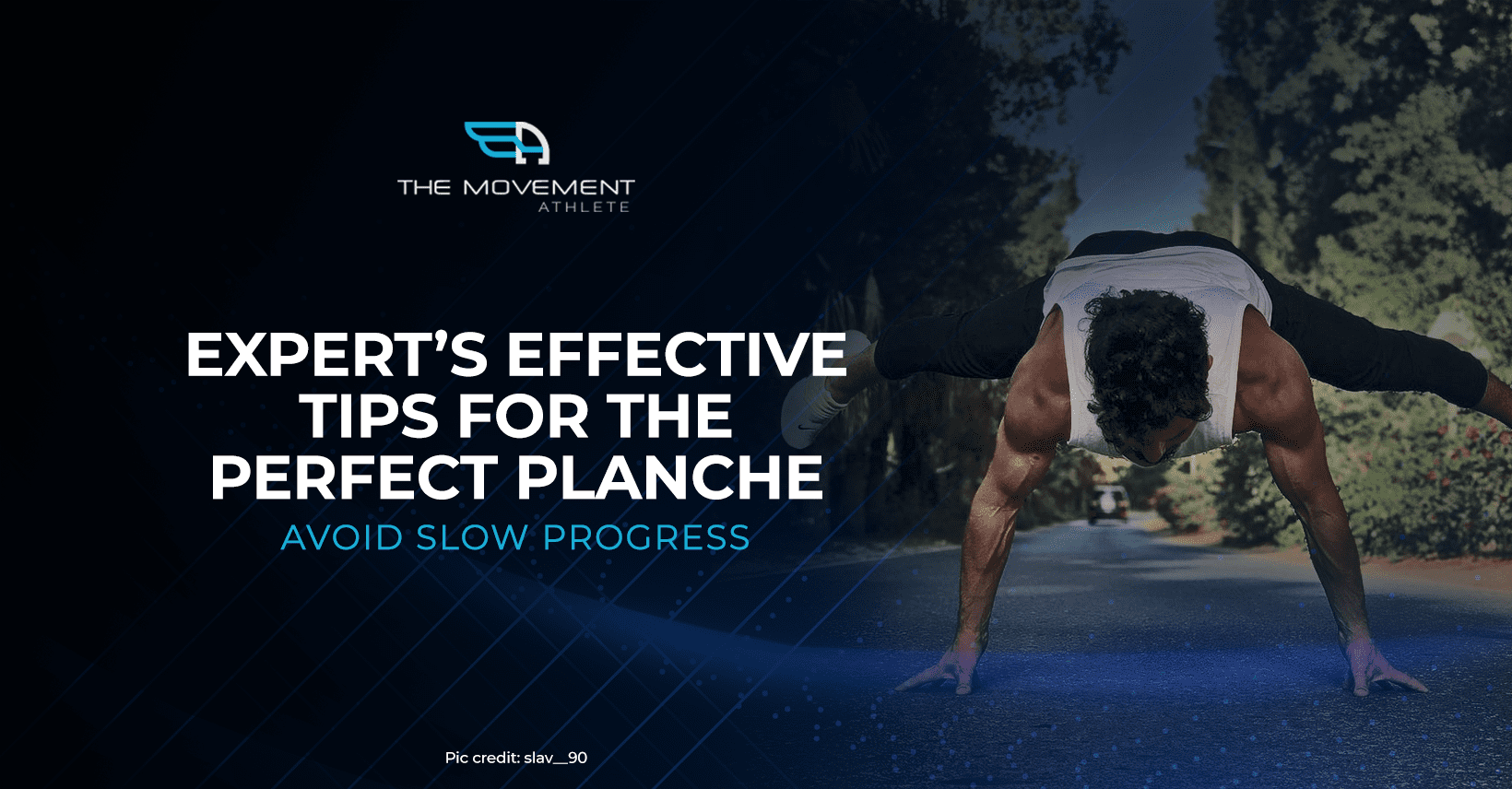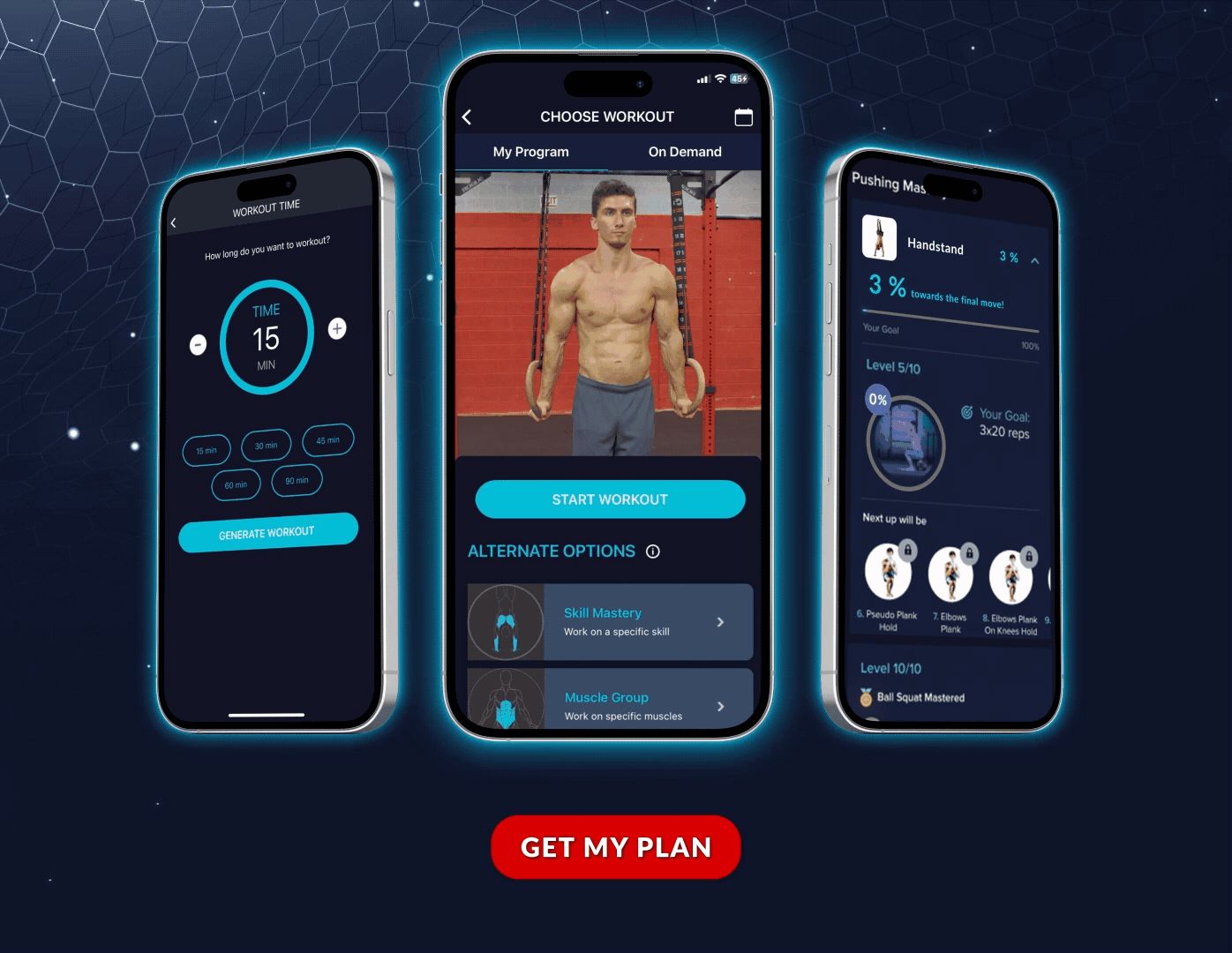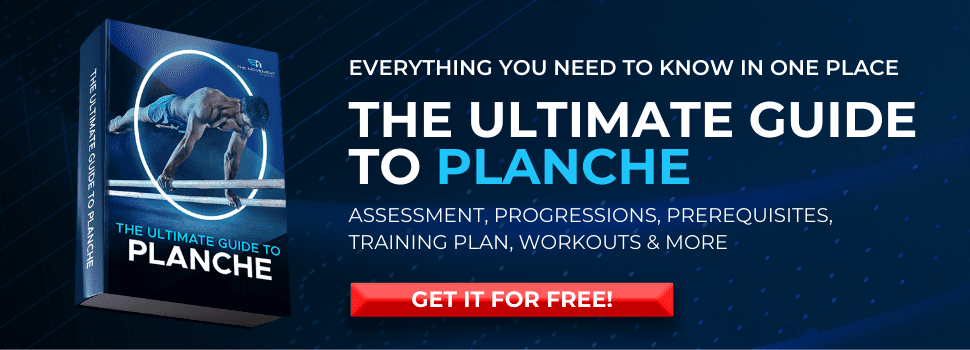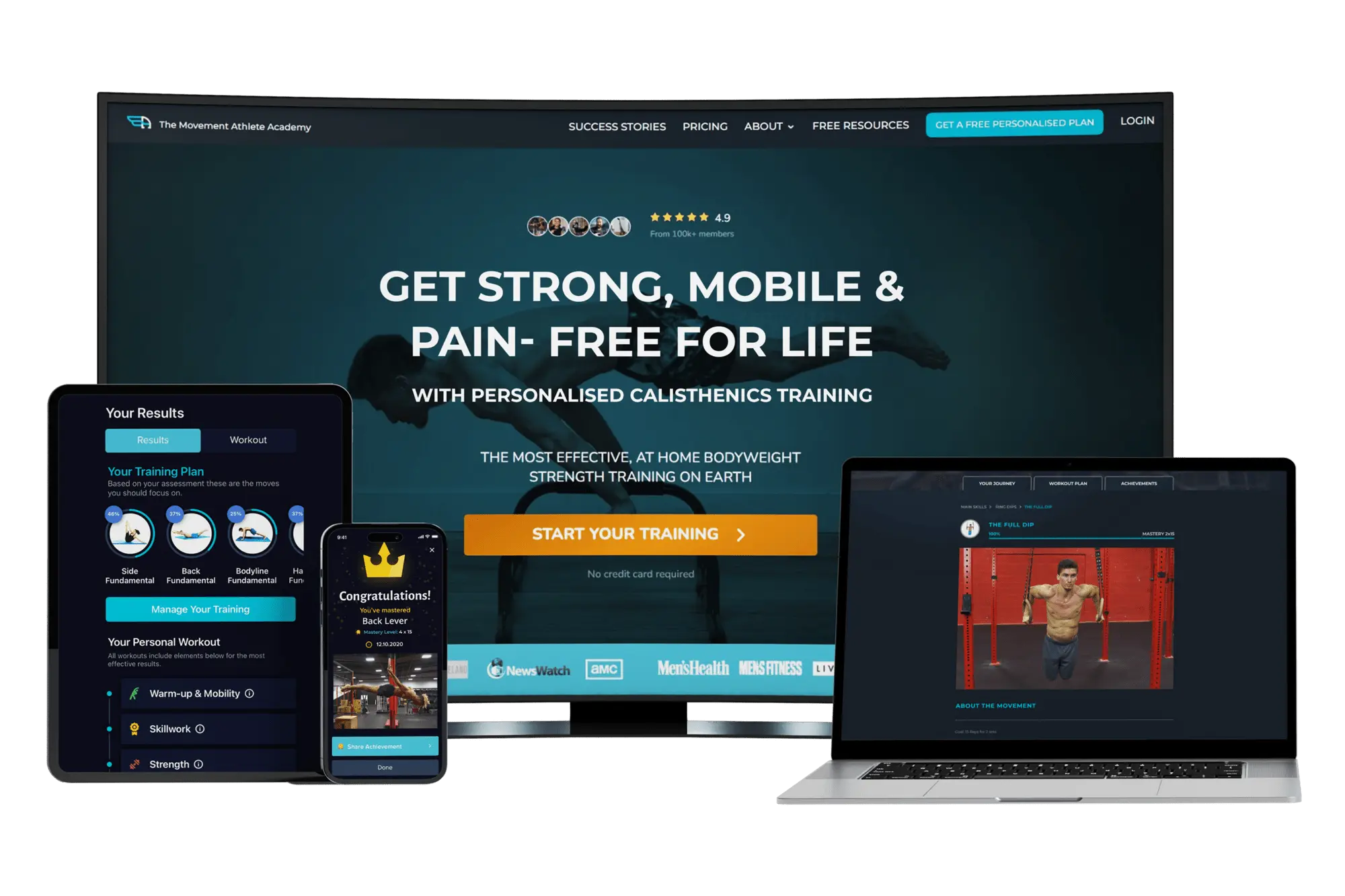

Expert Planche Tips: 6 Critical Mistakes to Avoid & 5 Game-Changing Techniques for 2024
📖 Read Time: 7 Minutes | 🎯 Difficulty: Intermediate-Advanced | 📅 Updated: September 2024 | 🎯 Focus: Technique Mastery
Join the tribe of Movement & Calisthenics Athletes
People just like you that are working with their own body weight to get strength, lose fat, build muscle, recover from injuries and live their best lives!
Why do only a few elite athletes worldwide hold the planche with perfect form? Because they’ve mastered specific techniques and avoided critical mistakes that derail most practitioners.
Most athletes spend years grinding away at planche training without progress, making the same fundamental errors that keep them plateaued. Don’t be another casualty of ineffective training methods.
Today, we’re revealing expert insights from elite calisthenics athletes and gymnasts who’ve mastered this ultimate horizontal skill. These proven strategies will transform your approach and accelerate your planche journey.
⏱️ Quick Planche Mastery Reference
| Critical Mistakes | Expert Solutions | Timeline Impact |
|---|---|---|
| Too many exercises | Focus on 3-4 specific movements | 50% faster progress |
| Non-specific training | 80% planche-specific work | Eliminates plateaus |
| Wrong progression level | 8+ second holds with perfect form | Prevents injuries |
| Bent arm compensation | Scale down, build straight-arm strength | Builds proper patterns |
🎯 What are the most common planche training mistakes?
The six most common mistakes are: doing too many exercises, non-specific training, attempting progressions too difficult for your level, allowing bent arms, not breathing during holds, and giving up during plateaus. Each can be corrected with proper technique and progression management.
👊 6 Critical Mistakes That Destroy Planche Progress
Why this section matters: Avoiding these mistakes will save you months of frustration and prevent injury while accelerating your progress toward the planche.
These critical pitfalls prevent faster and proper progress. Avoid these mistakes to keep your training productive and achieve your goal in a safer, faster and more efficient manner.
1. 🤜 Doing Too Many Exercises
A common mistake done by people is doing too many exercises in a given training session. This will prohibit you from building the volume needed for learning muscle memory and strength growth for the right muscle groups.
Stick to the most effective exercises in your main workout. There are far better, more efficient exercises that make better use of your time, especially when learning a skill.
2. 🤜 Doing Non-Planche-Specific Exercises
Something similar to the mentioned above is doing too many non-planche specific exercises. This will slow your planche progress and could even lead you to over-fatigue.
Now, we’re not saying ditch every other exercise. Having a balanced body is still our goal. This means you will not let go of pulling exercises and your leg day, but you would just need to schedule your training better.
If your main goal is to planche, it’s best to stick to exercises that guide you towards your goal, while adding a regular, but moderate number of other exercises for an overall strong and balanced body.
3. 🤜 Too Difficult Progression
DO NOT UNDERESTIMATE PLANCHE WORK. Usually this is the case when ego takes over. Choosing a difficult progression in which we cannot hold with perfect form for at least 8 seconds will only train us to form bad habits.
Dial down the ego and keep working what you can do. Not only will it prevent any injuries, it will also help you progress faster and keep the process enjoyable.
4. 🤜 Arms Not Straight
When doing too difficult progressions, a common breaking point of form is in the elbows. A bent arm is not a proper straight-arm planche. Duh!
If this happens, scale down to an easier exercise that allows you to keep your arms straight. Also focus on preparatory exercises that will build you stronger tendons.
Remember our joints are not accustomed to the straight arm loading. Keep your progress consistent no matter how slow you go. To give you a cue, push your elbow pits forward. Keep it straight!
5. 🤜 Not Breathing
Holding your breath, for sure, helps you hold your planche much longer, but this does more harm than good. Not breathing when training a planche progression will hinder your body from getting comfortable with the position.
Although it seems much more difficult at first, also focus on breathing when training planche progressions. This will help you get comfortable holding the planche and make your progress better and stronger.
6. 🤜 Giving Up Too Early
Not many people can planche. Why? Because most gave up within a slight sign of a plateau.
Planche is such an advanced skill. That’s why there are also tons of exercises and progressions as seen in the article “The Ultimate Planche Progression“. But this is not an excuse to give up if you really like to learn the move.
Aside from the natural steep learning curve for planche, if you feel you aren’t getting any progress, address your weak links. Take a video of yourself performing the planche and analyze where you could possibly be weak. The usual weak links are:
• Anterior deltoid strength to hold forward lean
• Wrist mobility
• Hip mobility
• Shoulder mobility
• Straight-arm strength
Keep your determination and stay smart with your training as you will eventually learn this horizontal skill in time.
☝️ 5 Game-Changing Expert Tips for Planche Mastery
Why this section matters: These proven techniques from elite athletes will accelerate your progress and help you develop perfect planche form from day one.
Now that you already know the mistakes to avoid and some of their solutions, here are the general guidelines for a better approach in training. These are reminders for your training journey that can also be used for other goals.
1. 👍 Master Full Body Tension
There are specific muscle groups that will be working extra hard to keep you in the planche position. Sometimes, form tends to break them down which is why you might be too focused on these muscle groups.
While keeping the muscles in check, never forget about the rest of your body. Advanced calisthenics skills such as a planche demands a powerful, full-body tension. Keep everything tight to get the most out of your body.
2. 👍 Always Return to Basics
No matter where you are in your fitness journey, no matter how advanced you are, the basics will always serve you well!
Solidifying and always going back to basics helps you address any weaknesses. It also secures your foundations as planche squeezes out every strength from you.
To give you a concrete example: wrist rocks seem to be an easy exercise that you can forget about once you get comfortable with it. The key is to always scale it for the exercise to become challenging. LEAN FORWARD EVEN FURTHER. This will add more resistance even to the most basic of exercises.
Basics are your best friend. Basic doesn’t mean easy.
3. 👍 Enter with Perfect Form
One way to ensure that you’re holding the correct form of planche is already preparing your body with the correct form before entering. Whichever progression you are in, make sure that you have the correct body line and posture before entering the planche. From your starting position, all you have to do is to lean forward until you have enough angle to lift towards the planche.
This way, you no longer have to worry about making adjustments with your form. Just maintain the correct bodyline and posture while moving towards the position.
4. 👍 Build Perfect Habits from Day One
Like for any other goals, the key to having good form is building good habits right from the very start of the journey.
Always make sure that you are in form when performing the planche. Stop and rest once your form starts to break. This teaches your body to maintain only the correct form.
Once your body has gotten used to this position, it will be difficult for you to even try out a bad form of planche.
5. 👍 Master Mental Visualization
Even with the massive strength and mobility demands, planche is still a skill. When learning a skill, visualizing yourself performing the skill supports your progress.
You can even do this anywhere, anytime you like! Simply visualize yourself preparing, entering and holding the planche. A study even supports this that mental practices translate to positive effects in motor skills acquisition.
📝 Quick Reference Summary
To Summarize:
Here again are the mistakes to avoid and tips to follow gathered from planche experts:
👊 Mistakes to Avoid:
1. Doing too many unnecessary exercises
2. Doing too many non-planche specific exercises
3. Practicing a progression too difficult for you
4. Practicing actual planche progression with bent arms
5. Not breathing with a relaxed manner during the planche hold
6. Giving up too early in your journey
☝️ Tips to Follow:
1. Full body tension during holds
2. Scaling and training with basic movement patterns
3. Entering planche position with already correct form
4. Continuous building of good habits
5. Mental practice of planche (visualizing)
These tips and mistakes to avoid from experts are vital for a safe, fast and efficient progress. Integrate this with discipline and a proper structured program such as the one we have on The Movement Athlete, then you’ll be floating towards planche in no time.
❓ Frequently Asked Questions
How long does it take to learn the planche?
For most athletes, achieving a full planche takes 2-4 years of consistent training. However, you can achieve tuck planche in 6-12 months and advanced tuck in 1-2 years with proper progression and dedication.
What are the most important muscles for planche training?
The primary muscles are anterior deltoids (front shoulders), serratus anterior, triceps, and core. However, planche requires full-body integration including wrist stability, back strength, and hip mobility.
Should I train planche every day?
No, planche training is very demanding on your joints and nervous system. Train planche-specific work 3-4 times per week with at least one rest day between sessions to allow proper recovery.
Can beginners start planche training immediately?
Beginners should first build basic strength with push-ups, dips, and handstand holds. You need solid fundamental strength and wrist conditioning before attempting planche progressions to avoid injury.
What’s the difference between planche and front lever training?
Planche is a pushing movement emphasizing anterior deltoids and triceps, while front lever is a pulling movement focusing on lats and posterior chain. Both require exceptional core strength but use different muscle groups primarily.
📊 About This Guide’s Methodology
This comprehensive guide was created using insights from elite calisthenics athletes and gymnasts who have mastered the planche. Our recommendations are validated by our team of certified movement specialists and continuously refined based on user outcomes from thousands of training sessions.
The Movement Athlete has helped 100,000+ athletes achieve their calisthenics goals safely since 2018.
🔥 Stop Making These Planche Mistakes
Frustrated with Slow Planche Progress?
Get Your Personalized Planche Training Plan in 5 Minutes
⭐⭐⭐⭐⭐ Used by 100,000+ athletes to master advanced calisthenics
✅ Avoid the 6 critical mistakes that kill progress
✅ Get your exact planche progression level
✅ Personalized training plan that adapts daily
✅ Expert form corrections and technique tips
✅ Safe progression path to prevent injuries
No credit card required • 5-minute assessment • Start your life-changing journey
“After years of no progress, TMA’s system helped me avoid the common mistakes. Finally achieved my tuck planche in 8 months!”
– Marcus T., 31, Software Engineer
“The expert tips transformed my training. I was making 4 out of 6 mistakes! Now my form is perfect and progress is consistent.”
– Amanda R., 28, Yoga Instructor
“As a former gymnast returning to training, this guide corrected my technique flaws. The breathing tip alone improved my holds by 5 seconds!”
– David K., 35, Former Gymnast


